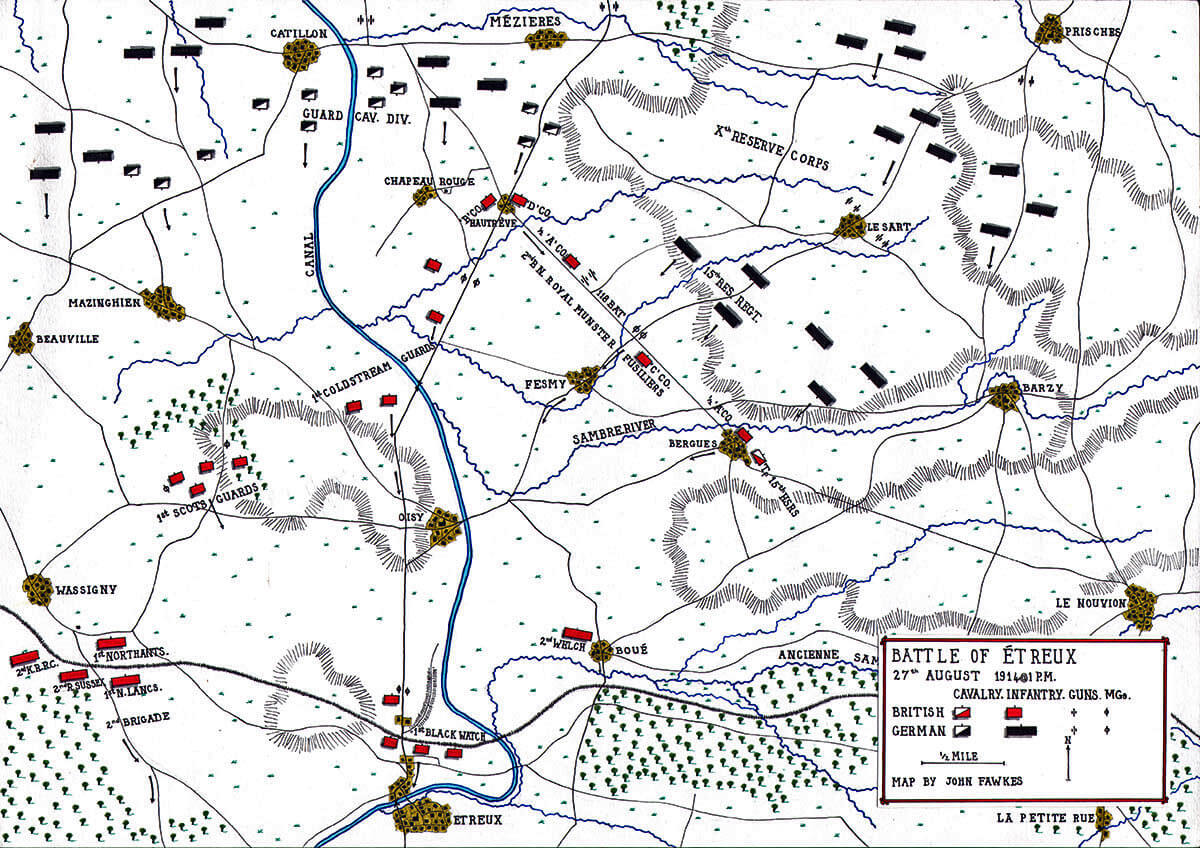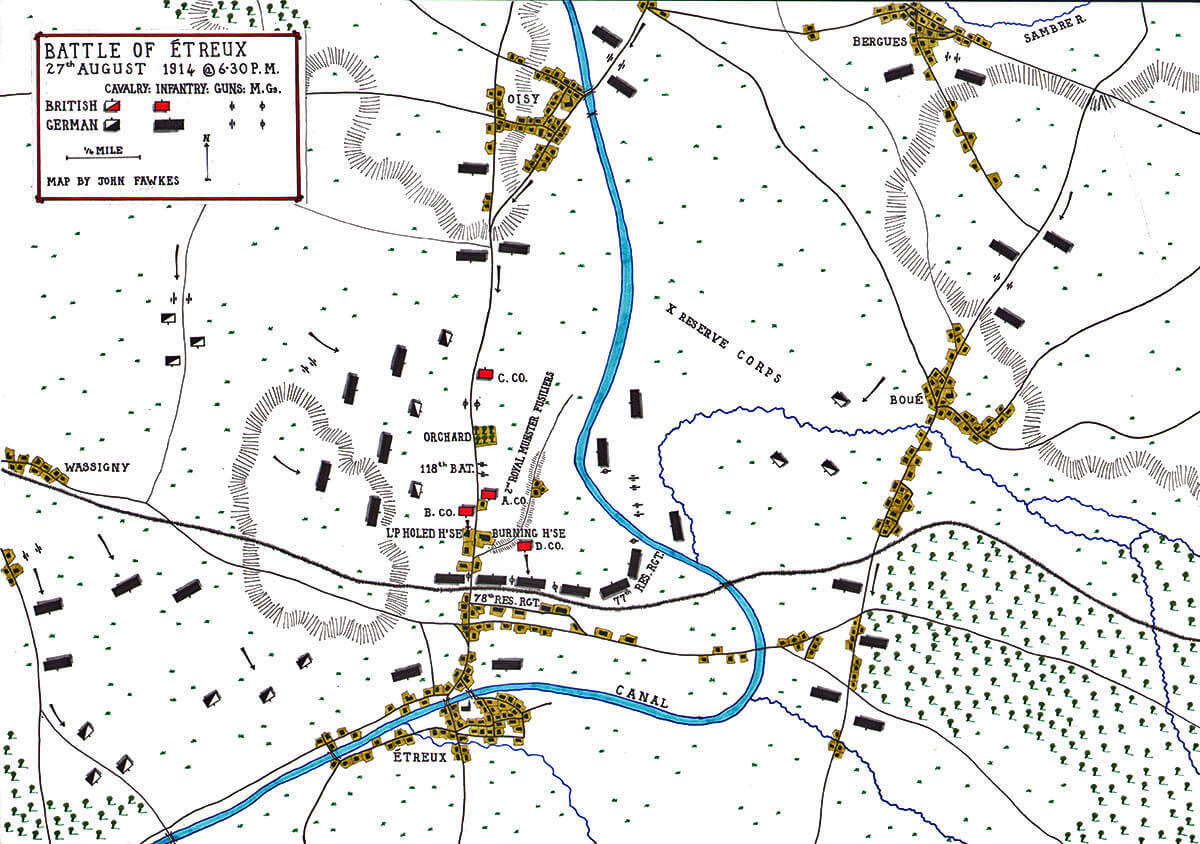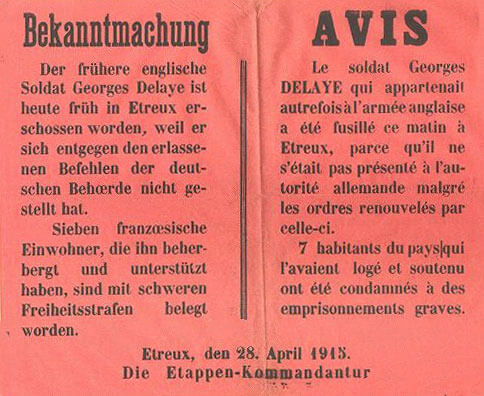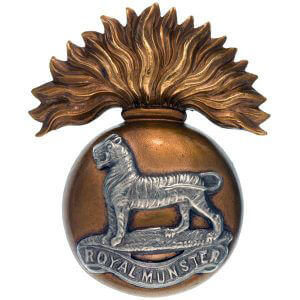The rear-guard action fought in France on 27th August 1914 by 2nd Royal Munster Fusiliers, holding up the German advance for much of the day
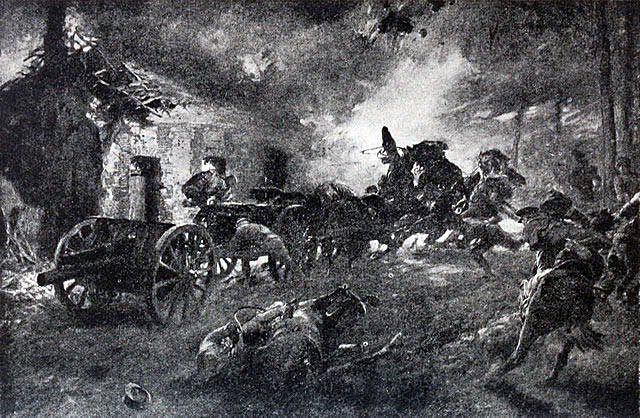
Royal Munster Fusiliers and Royal Artillery at the Battle of Étreux on 27th August 1914 in the First World War: picture by Christopher Clark
The previous battle in the First World War is the Battle of Le Grand Fayt
The next battle in the First World War is the Battle of Heligoland Bight
Date of the Battle of Étreux: 27th August 1914.
Place of the Battle of Étreux: In North East France, to the east of St Quentin.
War: The First World War also known as ‘The Great War’.
Contestants at the Battle of Étreux: The British Expeditionary Force (BEF) against the German First Army. This battle was an action by a small British force, acting as rear-guard for the BEF I Corps, against the pursuing formations from the German First Army.
Commanders at the Battle of Étreux: Field-Marshal Sir John French commanding the British Expeditionary Force (BEF) with Lieutenant-General Sir Douglas Haig commanding I Corps and General Sir Horace Smith-Dorrien commanding II Corps, against General von Kluck commanding the German First Army and General Bülow commanding the German Second Army.
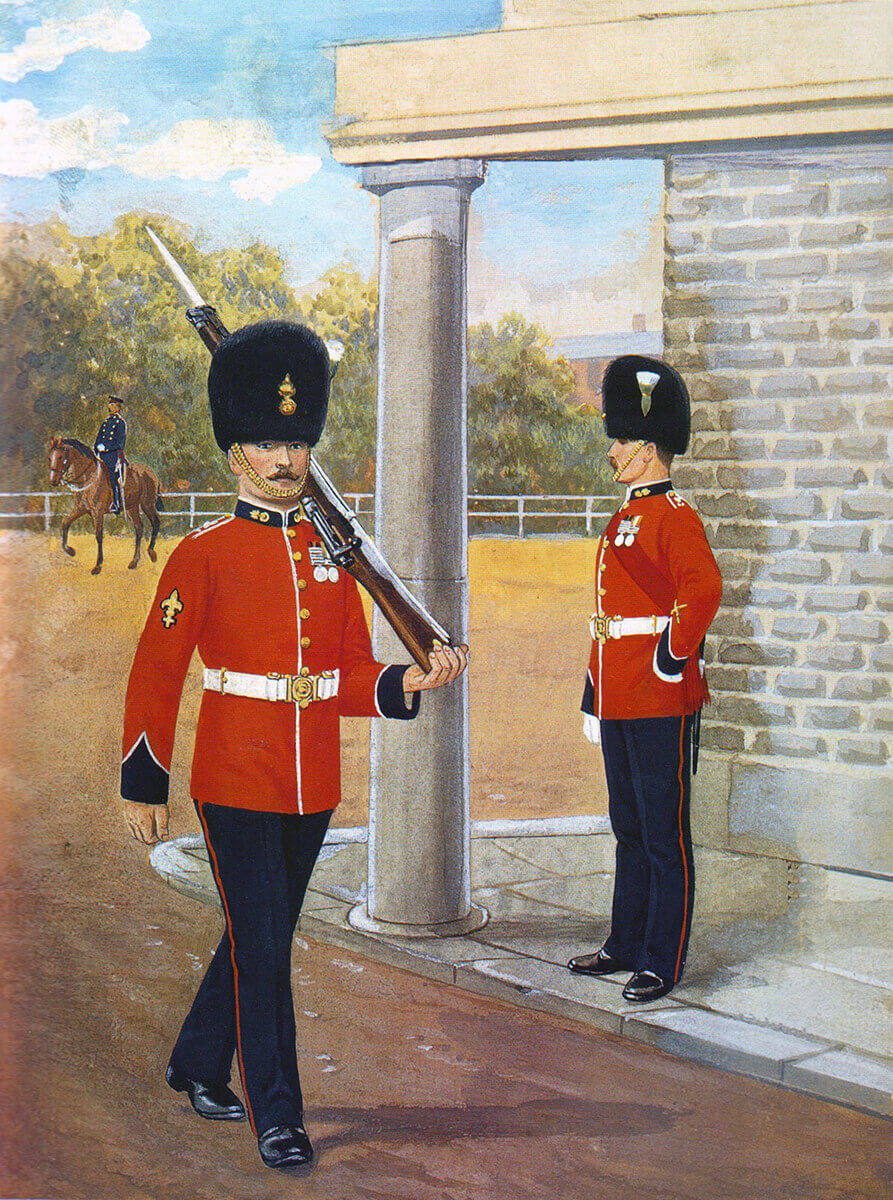
Royal Munster Fusiliers in Home Service Dress before the war: Battle of Étreux on 27th August 1914 in the First World War
Size of the forces at the Battle of Étreux:
The BEF comprised 2 corps of infantry, I and II Corps, the 4th Division, the 19th Independent Infantry Brigade and the Cavalry Division; 110,000 men and 330 guns.
The British formation engaged in the Battle at Étreux was: 1st Guards Brigade of the 1st Division of I Corps: 1st Coldstream Guards, 1st Scots Guards, 1st Black Watch and 2nd Royal Munster Fusiliers, with 1 troop from 15th Hussars and 1 section comprising 2 guns from 118th Battery RFA.
2nd Royal Munster Fusiliers comprised A, B, C and D Companies and the battalion Machine Gun Section.
The German troops engaged were from X Reserve Corps of the Second Army.
Uniforms and equipment in the Battle of Étreux:
See this section in the ‘Battle of Mons’.
Background to the Battle of Étreux:
See this section in the ‘Battle of Mons’.
The BEF at this stage in the Great War comprised around 30% current regular soldiers and 70% reservists with previous service in the Regular British Army. The British Army was the only major European army with recent experience of active service; in the Sudan from 1896 to 1897, South Africa in the Boer War from 1899 to 1901 and on the North-West Frontier of India. The German Army had not fought a war since the Franco-Prussian War in 1870-1.
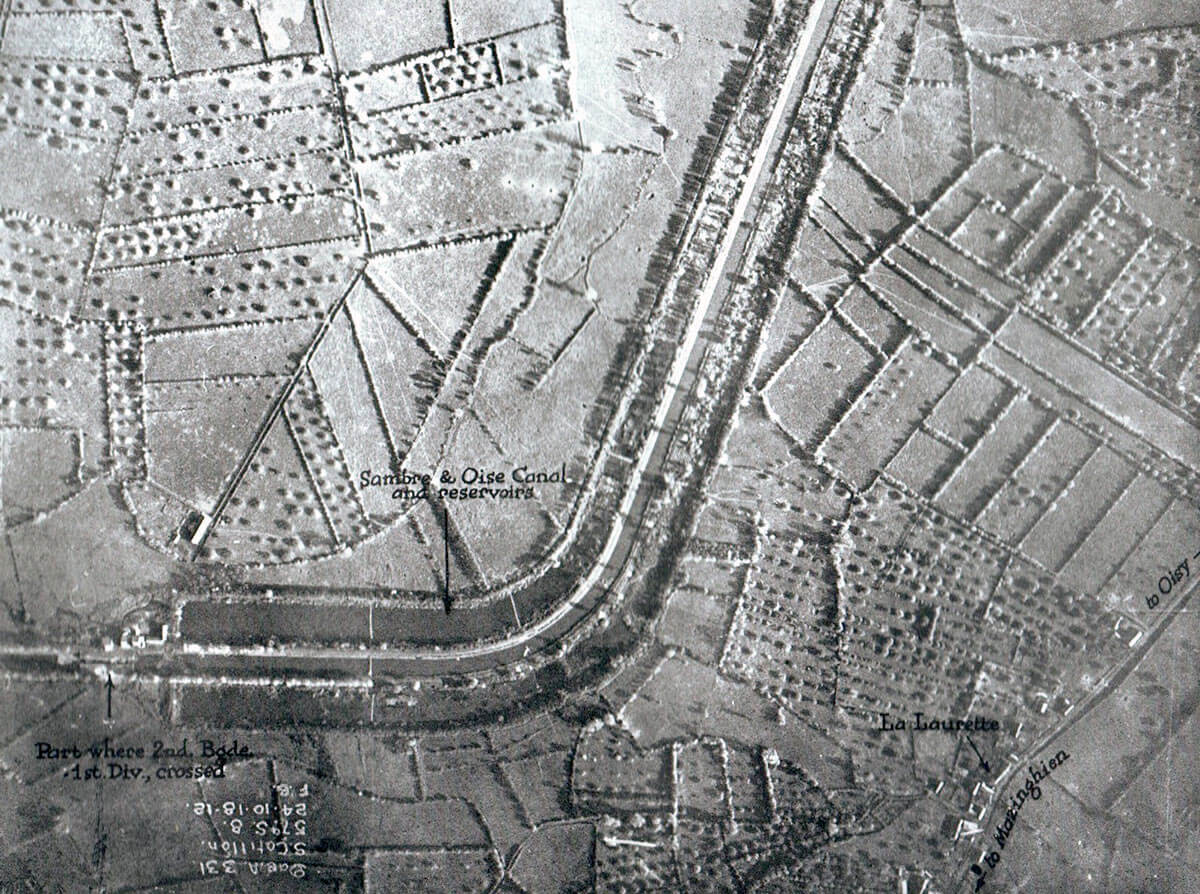
An aerial photograph showing the field layout on either side of the Sambre and Oise Canal at Oisy: Battle of Étreux on 27th August 1914 in the First World War
In these early battles of the Great War, the British soldiers outfought the Germans, although forced to retreat by pressure of numbers and the withdrawal of the French armies on their flanks. The British units’ ability to move about the battlefield in cover, and their facility to deliver high rates of accurate rifle fire repeatedly enabled them to repel attacks by massed German infantry. The British artillery units consistently provided support to the infantry with accurate gunfire, while manoeuvring about the battlefield with speed and resource.
This was the force the Kaiser described as a ‘Contemptible Little Army’. German officers were stunned by the way the British troops brought the German attacks to a standstill time and again.
During the course of 1914, the old British army melted away, as the casualties caused by artillery, machine guns and rifle fire mounted, until the ‘Contemptibles’ were largely gone, to be replaced by the new mass British Army of war-time volunteers and conscripts.
The courage and technical ability of the units in the BEF during 1914 is striking.
Account:
The II Corps of the British Expeditionary Force (BEF) spent the 26th August 1914 contesting the area to the west of Le Cateau with the pursuing Germans, assisted by the Cavalry Division, the 19th Infantry Brigade, and the newly arrived 4th Division (see the Battle of Le Cateau).
During the 26th August, the I Corps, comprising 1st and 2nd Divisions, commanded by Lieutenant-General Sir Douglas Haig, marched south from the area of Landrecies, on the edges of the Forest of Mormal, towards the town of Guise. This route was essentially down the east bank of the Sambre and the Oise Rivers and canal.
In order to pass through Guise, the only available route south lying on the east side of the Oise River, the I Corps’ transport was channelled through the town in two streams under careful supervision by corps staff officers. Only once the transport was clear of the town could the fighting formations pass through to the south.
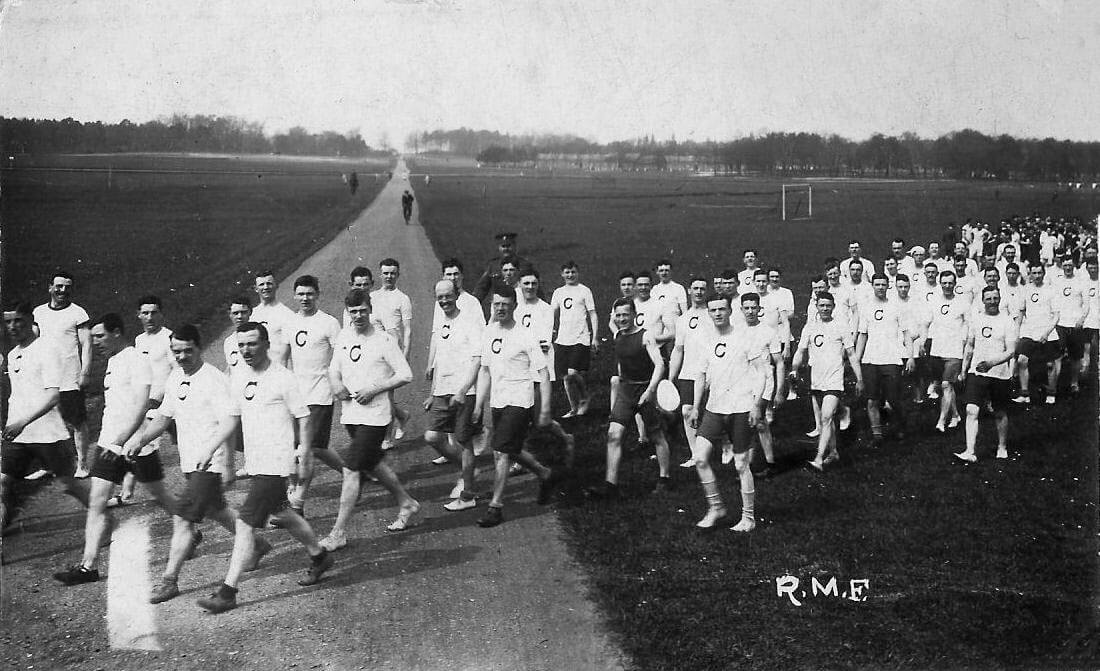
C Company 2nd Royal Munster Fusiliers marching to ‘PT’ in Aldershot before leaving for France. Within 1 month of arriving in France in August 1914, all the members of C Company were either killed or made prisoner in the Battle of Étreux on 27th August 1914 in the First World War
The pursuing Germans were reported to be in significant strength and closing in on I Corps from the north and the north east.
An erroneous report put the Germans just to the north of St Quentin, to the west of I Corps, adding to the urgency to pass the Corps through Guise as quickly as possible.
The fighting formations of I Corps were due to pass through the town of Étreux, 5 miles to the north of Guise, where they were to be re-supplied. These formations spent the night of the 26th/27th August 1914 in the area around and to the north of Étreux.
The I Corps rear guard was deployed to the north of Ētreux, to keep the Germans off the high ground between Wassigny, to the west of the Oise Canal, and Fesmy, just east of the road to Guise. The rear guard was expected to keep the Germans to the north of Ētreux until the 1st and 2nd Divisions were clear of this town and heading south towards Guise, expected to be during 27th August.
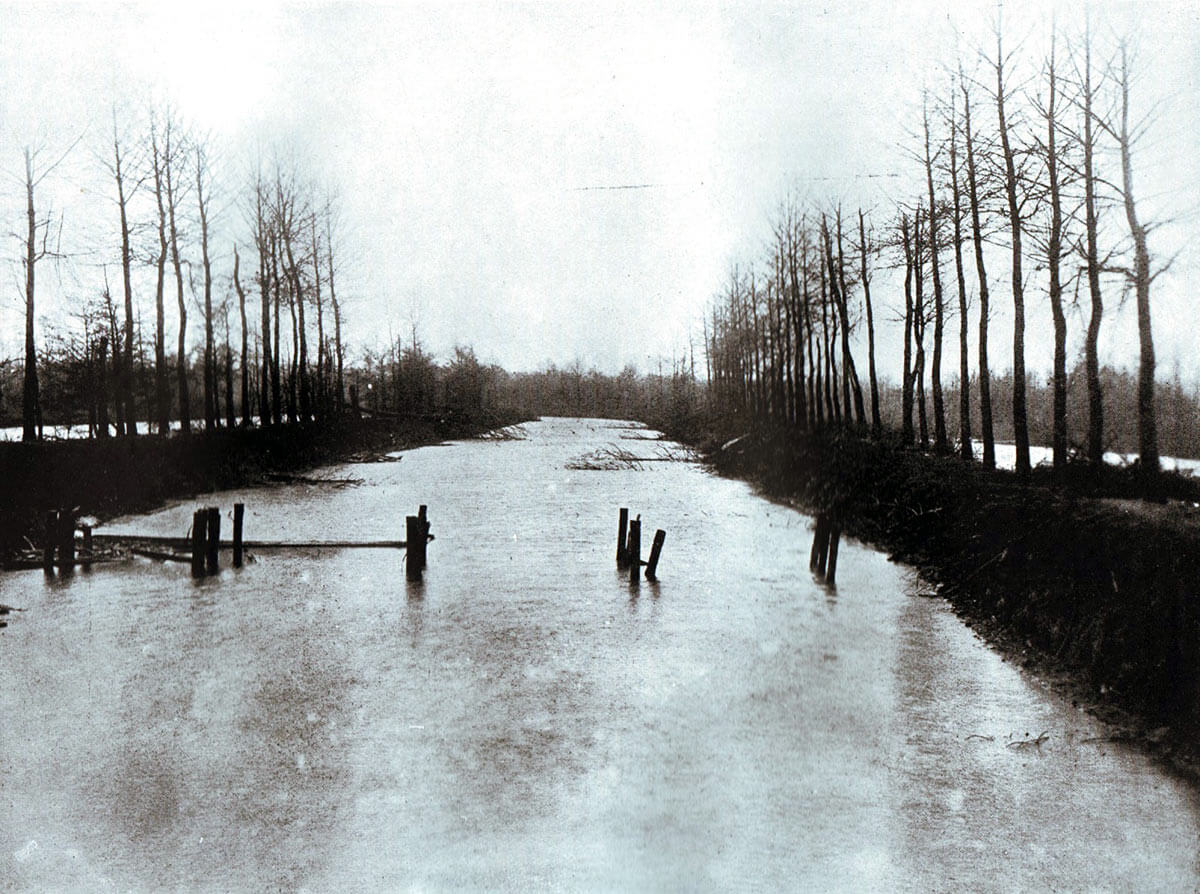
The Sambre and Oise Canal north of Oisy: Battle of Étreux on 27th August 1914 in the First World War
The covering units for I Corps, all taken from the 1st Division, were 1st (Guards) Brigade as the rear-guard, 2nd Brigade posted to the west of the canal, in the area of Wassigny, and the 2nd Welch Regiment, from 3rd Brigade, with 46th Battery RFA, as a guard to the east. The 5th Cavalry Brigade was marching down the west bank of the Oise.
With this cover, the Corps moved off, with the 2nd Division leading the 1st Division, through Ētreux and on through Guise, south-west down the east bank of the Oise River.
Of the 4 battalions of 1st (Guards) Brigade; 1st Coldstream Guards, 1st Scots Guards, 1st Black Watch and 2nd Royal Munster Fusiliers, the Royal Munster Fusiliers were given the post of ultimate rear guard for the Corps.
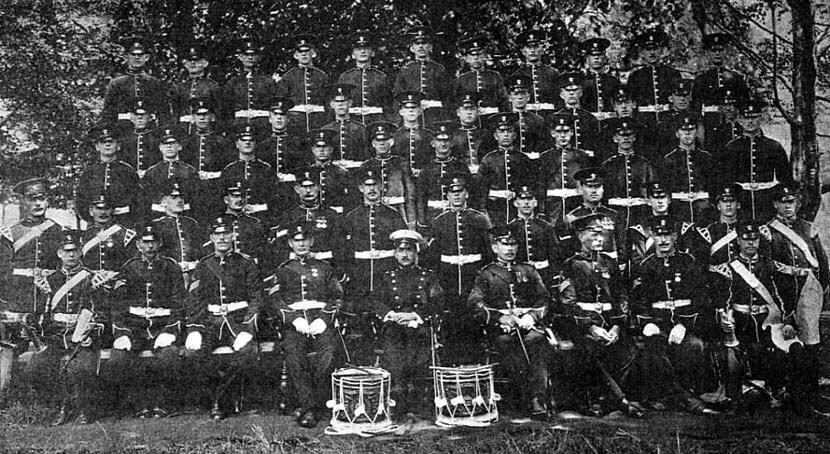
D Company, 2nd Royal Munster Fusiliers, at Tidworth in 1912 (this D Company will not have been the same D Company that fought in 1914, as in 1913 the companies in infantry battalions were doubled in size and halved in number, so that each battalion had 4 companies instead of the previous 8; each new company absorbing 2 of the previous companies, with a company sergeant major as the senior non-commissioned rank in place of the colour-sergeants): Battle of Étreux on 27th August 1914 in the First World War
The Royal Munster Fusiliers bivouacked on the night of 26th/27th August at Fesmy, on the road that ran south-east from the main Landrecies to Guise road. D Company of the battalion, commanded by Captain Simms, was positioned at the cross roads at a village named Hautrève. This village is called, in all the main accounts, Chapeau Rouge (and will be in this account from here on), although Chapeau Rouge is in fact a village some quarter of a mile west of the cross roads.
1st Scots Guards lay in positions towards Wassigny on the west side of the canal. 1st Coldstream Guards held positions on both sides of the canal, at the point where the road crossed the canal to the west bank and ran south for about 2 miles, before crossing back to the east bank at Étreux.
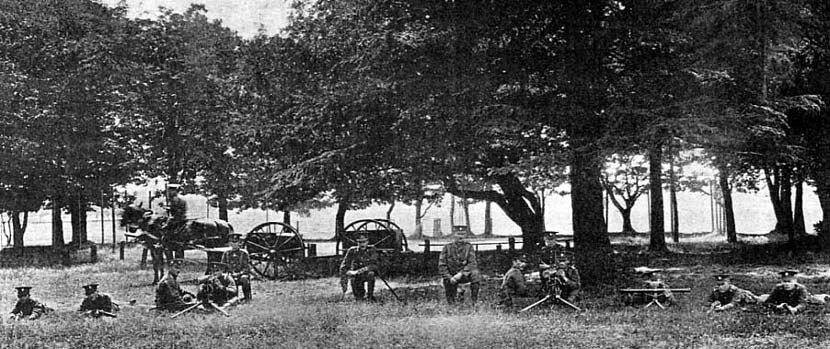
The Machine Gun section of 2nd Royal Munster Fusiliers at Aldershot immediately before the outbreak of war in August 1914. Lieutenant Chute is in the centre with Sergeant Johnson to his right: Battle of Étreux on 27th August 1914 in the First World War
1st Black Watch lay in reserve on the west bank of the canal at Étreux, where they dug entrenchments along the railway embankment; entrenchments later used by German troops to hold back the Royal Munster Fusiliers.
2nd Royal Munster Fusiliers comprised A, B, C and D companies and a 2 gun Machine Gun Section. With the Royal Munster Fusiliers was a 2 gun section from 118th Battery, RFA, and a troop of the 15th Hussars, the divisional cavalry regiment (the Official History refers to 2 troops, but accounts from officers present refer to only 1 troop).
The Royal Munster Fusiliers and the accompanying units were commanded by Major Paul Charrier, the acting commanding officer of the battalion. Charrier was a large, lively personality, who wore a hot weather service topee helmet, with a green and white Munsters hackle on the side, rather than a conventional service cap.
The Welch Regiment, with its accompanying battery, lay to the south east of Bergues, the next village to the south east of Fesmy. Bergues itself was occupied overnight by French troops.
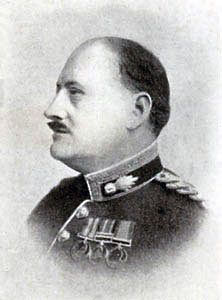
Major Paul Charrier, officer commanding 2nd Battalion Royal Munster Fusiliers at the Battle of Ētreux on 27th August 1914. Major Charrier was killed in the action: Battle of Étreux on 27th August 1914 in the First World War
The countryside was agricultural and divided into small fields, bordered by thick hedges inset with wire. For the troops of both sides this was extremely difficult countryside to cross, forcing attacks to be made principally down the roads. Considerable use was made of the drainage ditches along the roadsides for movement in cover.
The weather on the morning of the 27th August was misty, with heavy rain storms following during the day.
At 4am on 27th August, Major Charrier sent D Company, under Captain Jervis, to re-enforce C Company at the Chapeau Rouge cross-roads.
The Royal Munster Fusiliers got under arms at dawn, as did the rest of the brigade.
At 8am, battalion scouts reported to Major Charrier that the French had left Bergues and that the village was unoccupied. Charrier sent ½ of A Company, under Captain Woods, to hold Bergues.
At 9am German cavalry vedettes came down the Landrecies road towards the Chapeau Rouge cross roads. However, they fell back without engaging.
At around the same time, a German column of all arms was seen advancing from Le Sart to the north-east of the main battalion positions, but also retreated.
By 9.30am, all was again quiet on the battalion’s front. Charrier received a message from the commanding officer of the 2nd Welch, that his battalion was retiring to Boué, to the south of Fesmy.
Charrier also received orders from Brigadier-General Maxse, commanding 1st (Guards) Brigade, that the Royal Munster Fusiliers were to stay in place around Fesmy, until specifically ordered to retreat or they were forced out.
At 10.30am, the German assaults on the Royal Munster Fusiliers began. The first attack was on A Company at Bergues. There was also a build-up of German troops on the road approaching the Chapeau Rouge cross roads. The 2 gun section from 118th Battery, RFA, began firing to the north-west, on the German concentrations menacing Chapeau Rouge. At the Chapeau Rouge Cross-roads B and D Companies were well dug in.
Charrier sent the troop of 15th Hussars to reinforce A Company at Bergues. He also sent further platoons from A Company. Of these only the cavalry and Captain Emmerson with some of the A Company men managed to get through to Bergues.
At 11am, 3rd Brigade moved south from Oisy towards Étreux, as part of the 1st Division’s continuing retreat towards Guise. At around this time 2nd Welch reached Boué on their way south.
In the centre of the Royal Munster Fusiliers positions, the Germans began what was described at the time as a ‘brisk attack’. The Munsters replied with heavy rifle, machine gun and gun fire. This attack continued to build up from the direction of Le Sart in the north-east.
At midday, instructions arrived from Brigadier-General Maxse, directing that the battalion could withdraw via Boué, when the time came. Charrier had informed Maxse that this was his preferred route. No time was given for the withdrawal.
Also at around midday, a German aeroplane flew over the battalion positions, attracting a considerable amount of small arms fire which did it no apparent damage. It began to rain heavily.
At 12.20pm, Étreux finally cleared of transport and the I Corps fighting formations were free to continue the retreat. At 1pm, Brigadier-General Maxse sent out orders to his 4 battalions to retreat ‘at once’. 2 copies were sent to each battalion, apparently by cyclist, but neither copy reached the Royal Munster Fusiliers.
At 1pm, the Germans began a heavy attack on the Chapeau Rouge cross-roads. B and D companies of the Royal Munster Fusiliers fell back down the road to the main battalion positions around Fesmy, without suffering loss. The guns of 118th Battery were now firing on the German troops in the area Le Sart.
At around 1.15pm, the Germans launched an attack on Fesmy from the direction of Le Sart, with artillery support. The Royal Munster Fusiliers responded with gun and rifle fire and with the fire of their 2 gun machine gun section, commanded by Lieutenant Chute.
During the ensuing battle, Chute’s machine guns were at the forefront in holding off the repeated German attacks, firing down the roads at the advancing columns.
To try and shield themselves from the heavy small arms fire from the Munsters, the German infantry advanced down the Le Sart road behind herds of cows. All the Germans who penetrated the Munster’s positions became casualties or prisoners.
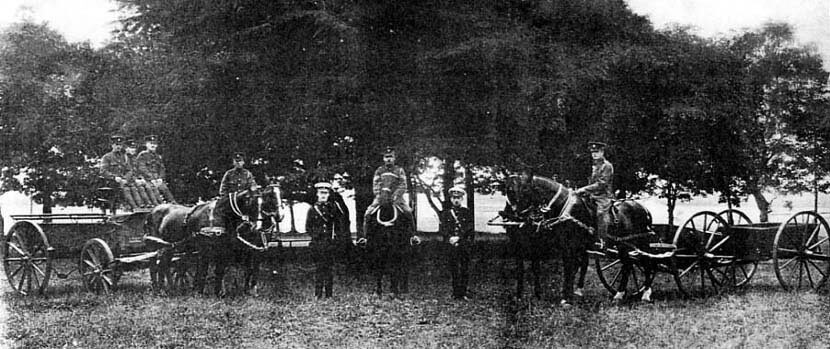
Transport section, 2nd Royal Munster Fusiliers in Tidworth in 1912: Battle of Étreux on 27th August 1914 in the First World War
At 1.15pm, Charrier sent a message to Brigadier-General Maxse: ‘Am holding on to position north of Fesmy village, being attacked by force of all arms. Getting on well. The Germans are driving cattle in front of them up to us for cover. We are killing plenty of them.’
At this time, Charrier despatched a platoon from A Company to join the Munsters/15th Hussars at Bergues. The platoon was driven back by the Germans and failed to reach Bergues. By this time, the party in Bergues was itself being driven out of the village and was falling back towards Boué.
At around 1.50pm, Charrier sent a message to Brigadier-General Maxse saying: ‘We have German wounded prisoners, who say “that about two regiments are opposing us and some guns. They belong to the 15th Regiment.”
In fact, the German regiment was the 15th Reserve Infantry Regiment.
At around 2pm, 2nd Brigade marched from Wassigny to Hannapes, to the south of Étreux, taking the road down the west bank of the canal. This left the 1st (Guards) Brigade as the last units facing the Germans advancing on Étreux.
At 2.30pm, although neither of the messages from Maxse had reached the Munsters, Charrier made the decision to withdraw towards Oisy. His original plan, approved by Maxse, to take the route through Bergues and Boué was no longer possible due to the German occupation of Bergues.
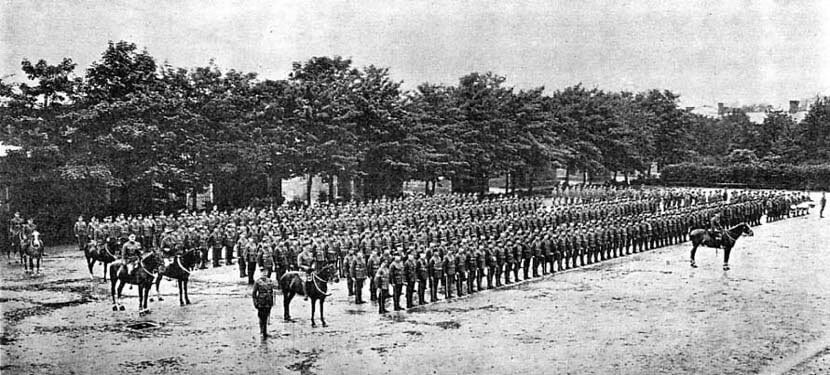
2nd Royal Munster Fusiliers at Tidworth in 1912: Battle of Étreux on 27th August 1914 in the First World War
The withdrawal began with D Company out as a left flank guard and B Company out on the right. Munster casualties at this stage were still light. Progress was slow, due to the difficult hedging surrounding each of the small fields in the area.
C Company brought up the rear and was subject to vigorous German attacks. The rear guard was engaged closely and fell well behind the rest of the companies, finally catching up at around 5.45pm.
At 3pm, the cyclist from 1st (Guards) Brigade Headquarters reached Oisy, after a substantial Odyssey around the countryside looking for the Munsters, pursued and shot at by various parties of German troops. The cyclist delivered Maxse’s ‘retreat at once’ order of 1pm to 2nd Coldstream Guards and the Coldstream prepared to march south towards Étreux.
At around this time, the ½ A Company of the Munsters arrived from Bergues with the troop of the 15th Hussars at Oisy. The Coldstream handed over the guard on the 2 canal bridges, 1 permanent and 1 built by the Royal Engineers, to A Company, Munsters, before marching south to Étreux. The 2 bridges had been prepared for demolition, but were not destroyed as this was now the only route for the main body of the Munsters, the Bergues-Boué road being occupied by the Germans.
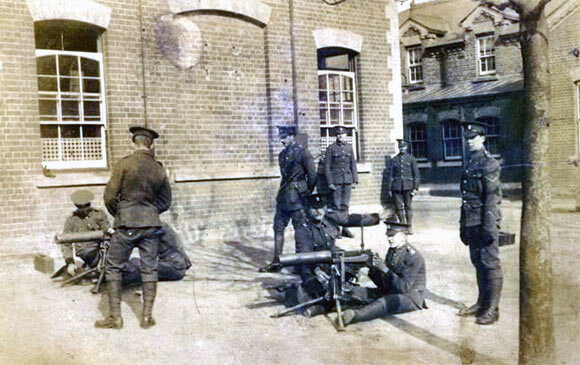
The machine gunners of 2nd Royal Munster Fusiliers: Battle of Étreux on 27th August 1914 in the First World War
The withdrawal and march south from Oisy by the Coldstream began at 3.30pm.
At around 4pm, strong German cavalry forces were seen to the west of Wassigny and were engaged by the British guns at Maison Rouge. The Germans were now hard on the heels of the 1st (Guards) Brigade.
It is not clear at precisely what time Charrier’s main body of Munsters (B, C, D Companies and the remainder of A Company and Chute’s Machine Gun section with the 2 gun section of 118th Battery, RFA) crossed the canal and reached Oisy. It was probably around 5pm.
C Company was left as the bridge guard, with a detachment under Lieutenant Awdry holding the north of Oisy.
Charrier continued south towards Étreux with A, B and D Companies, the machine guns, and the 2 RFA guns. To his rear, C Company withdrew down the road from Oisy, under covering fire from Chute’s 2 machine guns.
At around 6pm, Charrier’s leading troops approached the outskirts of Étreux. German soldiers were in the road ahead of them. It was clear that the Munsters were cut off.
The road into Étreux was blocked by 6 battalions of the German 73rd and 77th Reserve Infantry Regiments supported by a number of machine guns. The German infantry had occupied and loop-holed the first house in Étreux, on the west side of the road and were positioned in and around the other houses in the northern outskirts of Étreux. Several German battalions were holding the trenches dug by the Black Watch earlier in the day along the railway embankment, which cut across the road. There were further German infantry and guns on the far bank of the canal a mile to the east. More German infantry and cavalry were closing in from the west. Substantial German forces were following up behind C Company from the north.
A farmhouse on the east side of the Oisy-Étreux road burst into flames. This seemed to act as a signal to the various German forces surrounding the area. It would be a fair description to say that ‘all hell was now let loose’ as the German troops opened fire on the Munsters from south, east and west.
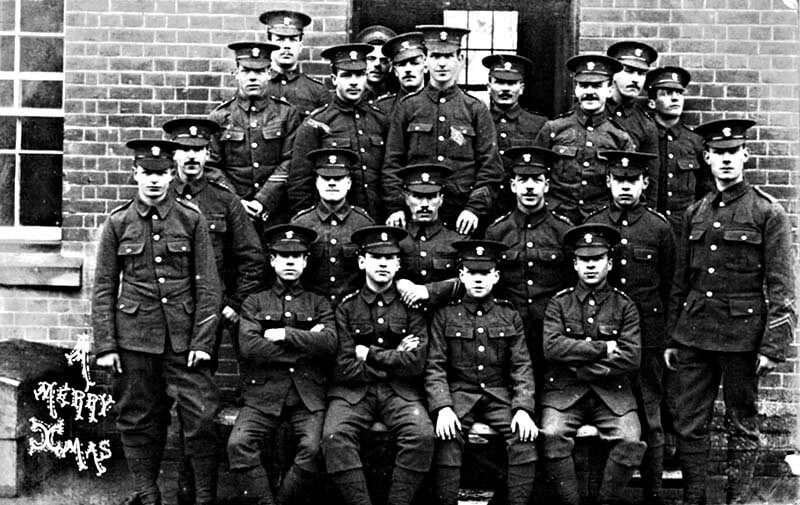
Platoon of 2nd Royal Munster Fusiliers in Tidworth in 1912: Battle of Étreux on 27th August 1914 in the First World War
The 2 guns of 118th Battery came into action against the German batteries on the far side of the canal, but after a full day of firing they were low on ammunition. Positioned on the road, the guns had no cover and a number of British gunners and horses were quickly shot down.
To escape to the south, Charrier decided that his only course was to attack into Étreux and try to clear the Germans from his path to the bridge and into the main part of the town.
Second Lieutenant O’Malley was sent to direct C Company to hold the rear, which he did by bicycle, managing to avoid the storm of fire being laid on the road. 2 ammunition carts were sent back to re-supply C Company with ammunition.
Lieutenant Chute brought his machine guns up from the rear to support the attack and D Company moved into an orchard on the east side of the road.
Charrier, with his adjutant Captain Wise, led B Company in an attack on the loop-holed house. ½ of A Company came up in support. B Company was heavily engaged with fire from both sides of the road. The attack failed and Charrier was wounded. Wise managed to reach the house and fired his revolver through a loop-hole before being stunned by falling masonry.
Despite his wound, Charrier led a second attack on the loop-holed house. This attack also failed, under the heavy fire from the house and the German infantry around the house and in the entrenchments along the railway embankment. Captain Simms, the company commander of B Company, was killed.
Company Sergeant Major McEvoy, the CSM of B Company, went back to bring up re-enforcements, calling “Come on boys. The Irish never lost a Friday’s battle yet.”
Charrier led a third attack on the loop-holed house which also failed in the face of the heavy fire.
The Munsters were now suffering heavy casualties under the relentless fire from all sides by rifles, machine guns and field guns.
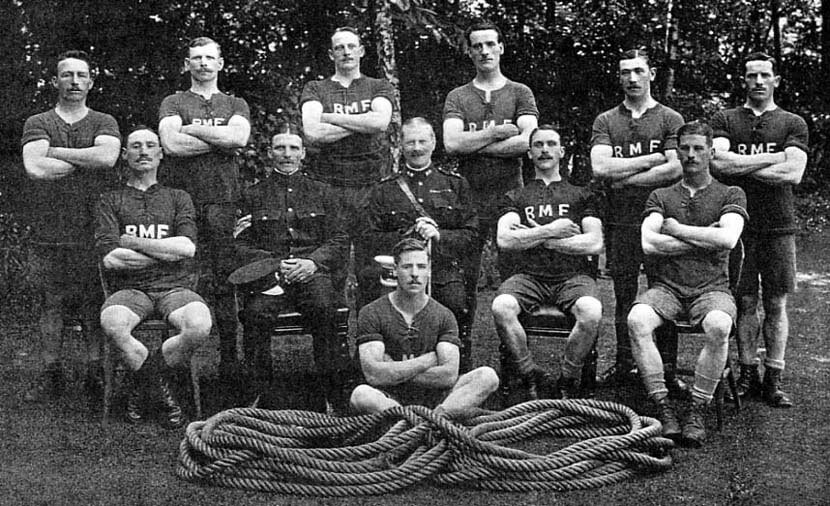
Tug of War team of 2nd Royal Munster Fusiliers in Tidworth in 1912: Battle of Étreux on 27th August 1914 in the First World War
While directing his machine guns, Lieutenant Chute ran across the road. He was struck by 2 bullets and killed. Sergeant Johnson continued in command of the 2 machine guns, firing until all the ammunition was exhausted, whereupon Johnson and his gunners smashed the guns.
1 of the 118th Battery field guns was knocked out by the gunfire from the east side of the canal. Charrier brought the second gun up, to fire on the loop-holed house, but all the gun crew and team horses were shot down by rifle and machine gun fire from the town.
Charrier now ordered C Company up in support of B and A Companies, in their assault on the loop-holed house and directed D Company, under Captain Jervis, to launch an attack on the Germans in the entrenchments along the railway embankment.
It may be that Charrier hoped to clear an alternative route to the bridge or still intended to capture the loop-holed house, once its support was driven off.
Jervis took his men along a sunken lane towards the embankment and launched his attack from the cover of the lane, moving forward by alternate rushes to within 70 yards of the Germans and then charging, supported by the fire of one of the A Company platoons. All the officers and soldiers in D Company were shot down in the attack, except Jervis himself, who was captured.
Charrier was wounded for a second time as he directed his troops from the road. Shortly afterwards he was in the road by the disabled gun, when he was shot again and killed.
The time was 7pm. The Munsters were under heavy attack from the south, east and west. The battalion, under the command of Captain Hall, fell back to the orchard, where Hall was wounded.
Command now fell on Lieutenant E.W. Gower, the senior unwounded officer. The battalion resisted repeated attacks on the orchard until 9.15pm, when, with ammunition virtually spent, the battalion was overwhelmed and the survivors taken prisoner.
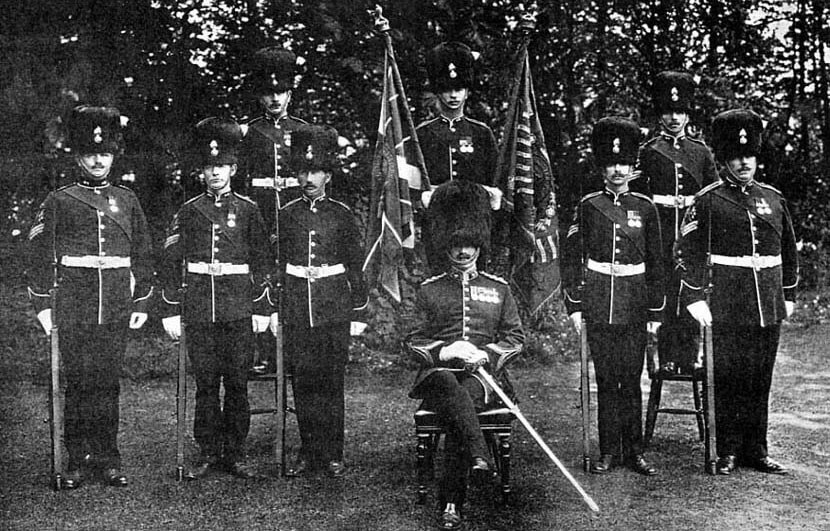
Colours and the battalion’s colour sergeants of 2nd Royal Munster Fusiliers with the then commanding officer, Lieutenant Colonel Boyle, in Tidworth in 1912: Battle of Étreux on 27th August 1914 in the First World War
Casualties:
The casualties in the battle on the British side were substantially from 2nd Battalion Royal Munster Fusiliers.
Of the Munsters, 4 officers and 256 soldiers, wounded and unwounded, were captured in the orchard, when the battalion was finally overrun. In the whole battle, 6 officers and around 500 soldiers of the battalion were made prisoner, many of them incapacitated by wounds.
It is not known what casualties were suffered by the 15th Hussars troop or the section of 118th Battery. Probably most, if not all, of the hussars and gunners were either casualties or captured.
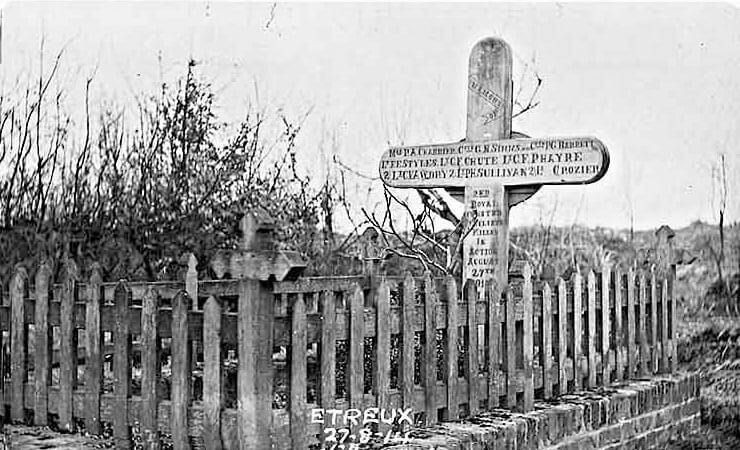
The graveyard in which the dead from the battle were buried and the memorial marking the grave of the Royal Munster Fusiliers officers killed on 27th August 1914, erected soon after the battle: Battle of Étreux on 27th August 1914 in the First World War
The next day the Germans caused parties of Munsters to collect the battalion’s dead and wounded from across the battlefield. The Germans permitted the Munsters to create a graveyard in the orchard and a memorial was built for the dead officers.
The Munsters’ officers killed in the battle and buried in the orchard were: Major Charrier, Captains Simms MVO and Barrett, Lieutenants Styles, Chute, Phayre and Awdry and Second Lieutenants Crozier and Sullivan. 82 soldiers from the battalion were buried in the orchard.
The soldiers from 118th Battery buried in the orchard comprised Battery Sergeant Major Strutt and 6 others. 1 private from the 15th (King’s) Hussars is buried in the orchard.
The Munsters’ officers wounded in the battle were Captains Hall, Wise and Rawlins, Lieutenant Deane-Drake and Second Lieutenants Moseley, Thomas, Green and White Haddon.
Munsters reported that, after the battle, many buildings in Étreux were used to house German wounded, which seemed to number around 1,500. It would be reasonable to assume that the Germans suffered around 2,000 casualties in all, during the battle. This would have been more than double the size of the Munster force.
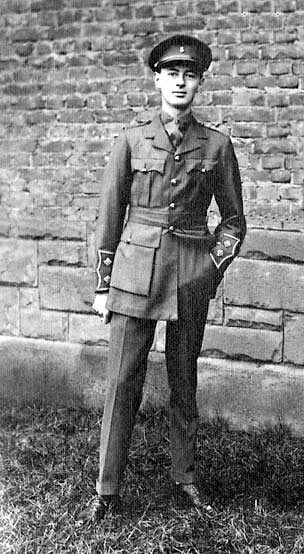
Lieutenant Harry Newsom, 2nd Royal Munster Fusiliers, an unwounded officer captured at the Battle of Étreux: photographed after his capture and while a prisoner of war in Torgau, Saxony: Battle of Étreux on 27th August 1914 in the First World War
The Munster prisoners reported that the German Corps Commander was furious when he realised the size of the force he had been fighting. Lower ranking German soldiers were complimentary of the conduct of the Munsters in resisting for so long and with such vigour.
After the battle, 2nd Royal Munster Fusiliers assembled 5 officers and 196 soldiers.
Aftermath to the Battle of Étreux:
Brigadier Edmonds, the British Official Historian of the Great War, records that the Munsters fight at Étreux delayed the German pursuit of the BEF I Corps for 6 hours, enabling the rear formations to get through the Guise bottleneck and retreat south.
Decorations and campaign medals for the Battle of Étreux:
Étreux is not a battle honour. Decorations for the battle were awarded after the War, in 1920. Little was known of the circumstances of the battle on the British side at the time, as everyone involved was either killed or captured, although reports began to be sent to Britain by captured officers and soldiers. Captain Wise received the Military Cross. A number of soldiers, including CSM McEvoy, received the Military Medal.
It would be reasonable to suppose that Major Paul Charrier would have received the DSO, had he lived. The DSO is an order, not strictly a decoration for bravery and there is no provision for its award posthumously.
Anecdotes and traditions from the Battle of Étreux:
- The Royal Munster Fusiliers were formed in 1881 from 101st Royal Bengal Fusiliers and 104th Bengal Fusiliers, European regiments in the Old East India Company Bengal Army taken over by the British Crown after the Indian Mutiny. Both regiments had a long and distinguished record in India before becoming the Royal Munster Fusiliers.
- During the Battle of Étreux, 2nd Royal Munster Fusiliers was in action against an entire German corps. Directly exchanging fire with the Munsters were the 3 battalions of the 15th Reserve Infantry Regiment and the 6 further battalions of the 73rd and 77th Reserve Infantry Regiments; all of the X Reserve Corps. In addition, there were batteries of German guns and cavalry units in the fighting around Étreux.
- Mrs Rickard, the wife of a Munsters commanding officer killed at Rue du Bois on 9th May 1915, wrote a book, entitled ‘The Story of the Munsters at Étreux, Festubert and Rue du Bois’, towards the end of the war. The book has, as appendices, reports and letters from Munster officers and soldiers held in Germany, dealing with the Battle of Étreux.
- Little mention is made in the various records of the part played by the 15th Hussars troop during the battle, after the fighting in Bergues. The troop seems to have suffered one fatal casualty. It may be that the troop marched south with the Coldstream, after the retreat to Oisy and took no further part in the battle.
- 5 soldiers from the Munsters and a 15th Hussar evaded capture at Étreux and were hidden by French civilians in the village of Iron, near Guise, along with 5 Connaught Rangers, separated from their battalion at Le Grand Fayt on 26th August 1914. On 22nd February 1915, these soldiers were betrayed to the German garrison and taken prisoner. After a summary trial, the 11 British soldiers with M. Chalandre, who had hidden them in his farm, were shot, in the grounds of the chateau at Guise on 25th February 1915. The houses of French civilians who were considered to have assisted the British soldiers were burnt and a number of French civilians were given lengthy prison sentences. The soldiers were Lance Corporal Moffatt and Privates Buckley, Horgan, Innocent and Nash of 2nd Royal Munster Fusiliers, Lance Corporal Stent of the 15th (King’s) Hussars and Privates Howard, Murphy, Thompson, Walsh and Wilson of 2nd Connaught Rangers from 5th
- A memorial to the 11 British soldiers and the French civilian, shot by the German Army on 22nd February 1915, was dedicated in the churchyard in Iron and a plaque placed in the grounds of Guise Chateau by various organisations including the Royal Munster Fusiliers Association and the Light Dragoons on 25th October 2011.
- A further British soldier was shot in similar circumstances on 28th April 1915, Private George Lay of 1st Berkshires. A poster was issued by the German military authorities in French and German, which translated states: The soldier Georges Delaye who formerly belonged to the English army has been shot this morning at Etreux, because he did not present himself to the German authority in spite of repeated orders by it. Etreux 28th April 1915. The Area Commandant. Despite the errors in his name, this is clearly a reference to the execution of Private Lay, who is buried in Etreux Communal Cemetery.
- The German military authorities in this area appear to have taken the view that, to be a legitimate combatant, it was necessary to be with a formed military unit and that once separated from his unit and in an area under German military rule, a British soldier became susceptible to German military law and was required to obey German military orders, even if he had not been captured and was in British military uniform. The offence the German military authorities considered these soldiers to have committed was their failure to give themselves up to the German army, in obedience to written directions posted in the town.
- In 1921, Captain Walter Styles MP, the brother of Lieutenant Styles, killed in the battle, bought the orchard at Étreux and made it a cemetery and commemorative garden in remembrance of the soldiers killed in the battle. The garden was dedicated in a ceremony on 4th June 1922.
References for the Battle of Étreux:
The Official History of the Great War by Brigadier Edmonds August-October 1914.
The History of the Royal Munster Fusiliers.
The Story of the Munsters at Étreux, Festubert and Rue du Bois by Mrs Victor Rickard.
The previous battle in the First World War is the Battle of Le Grand Fayt
The next battle in the First World War is the Battle of Heligoland Bight
